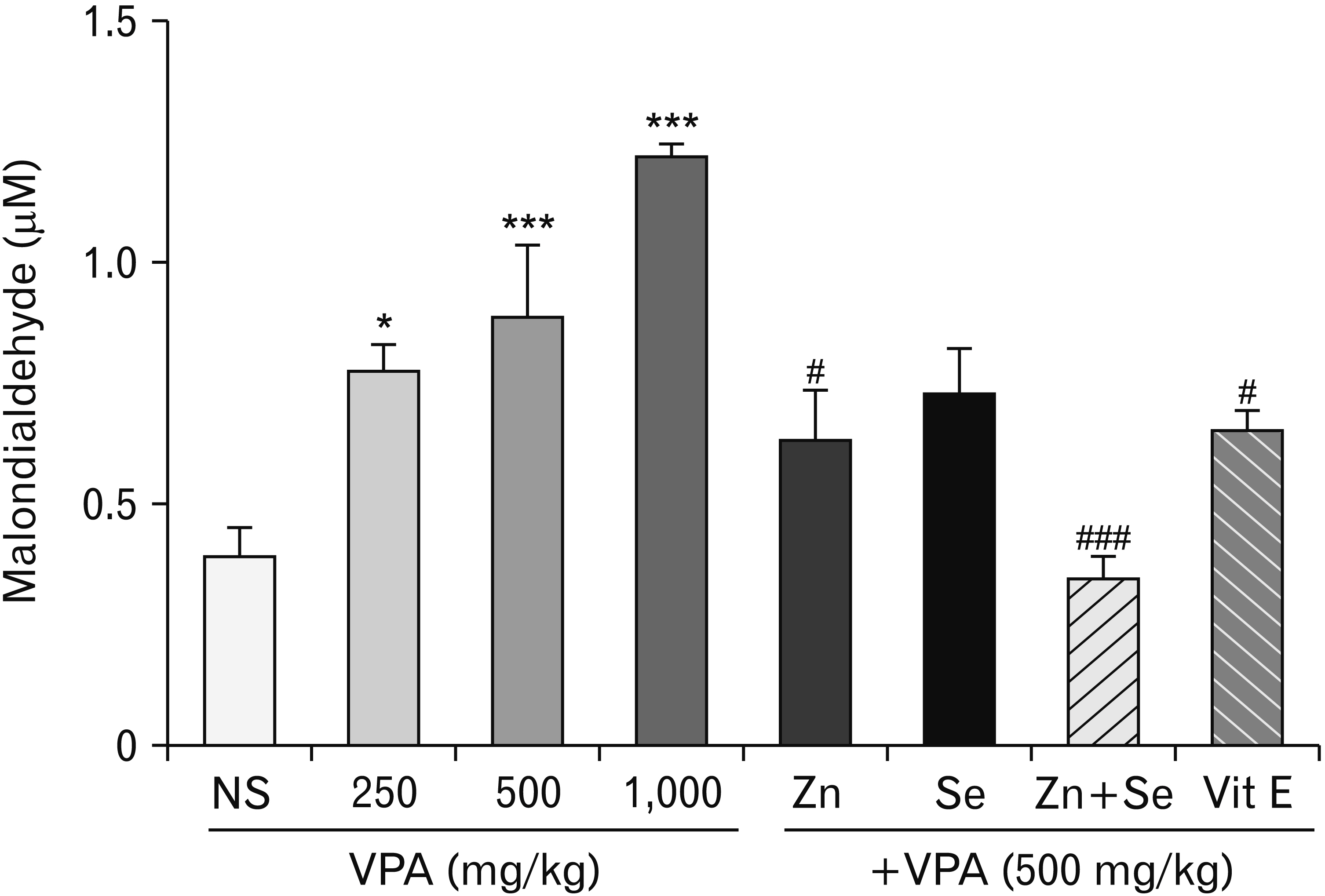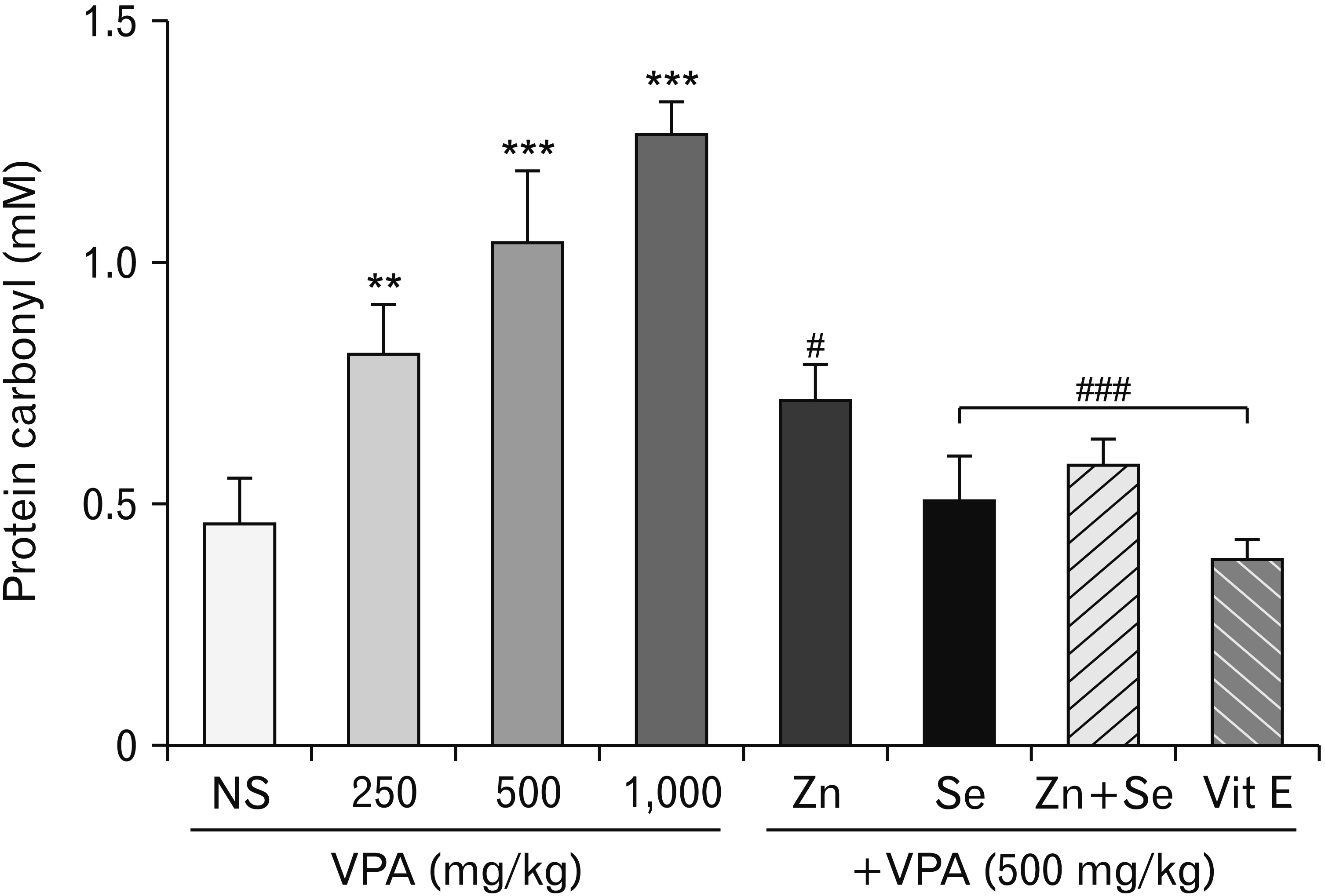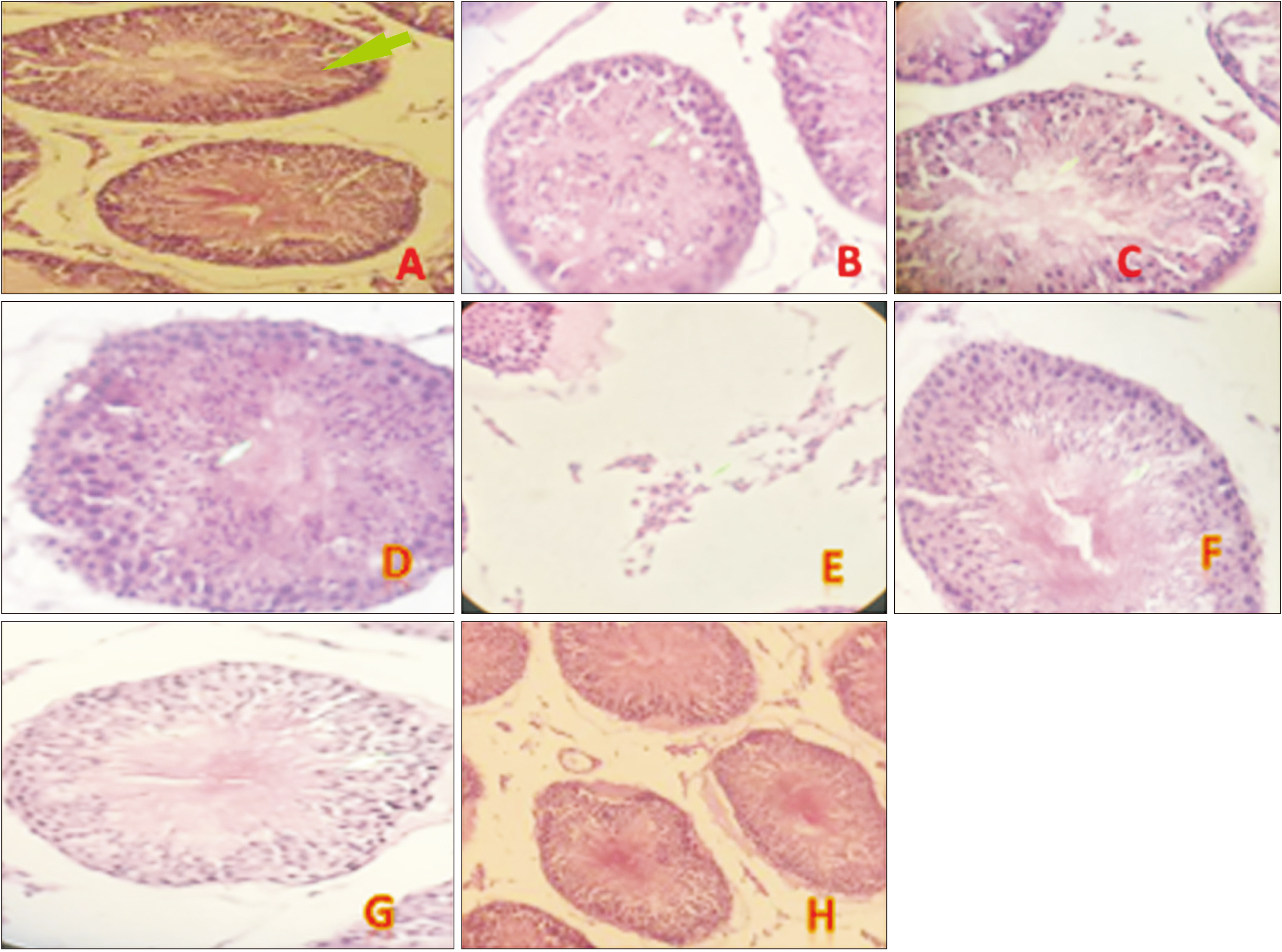Anat Cell Biol.
2021 Sep;54(3):387-394. 10.5115/acb.20.280.
Zinc and selenium supplement mitigated valproic acid-induced testis toxicity by modulating the oxidative redox balance in male rats
- Affiliations
-
- 1Pharmaceutical Sciences Research Center, Hemoglobinopathy Institute, Mazandaran University of Medical Sciences, Sari, Iran.
- 2Student Research committee, Mazandaran University of Medical Sciences, Sari, Iran.
- 3Department of Pharmacology, School of Medicine, Guilan University of Medical Sciences, Rasht, Iran.
- 4Immunogenetics Research Center, Faculty of Medicine, Mazandaran University of Medical Sciences, Sari, Iran.
- 5Department of Toxicology and Pharmacology, Faculty of Pharmacy, Mazandaran University of Medical Sciences, Sari, Iran.
- KMID: 2521051
- DOI: http://doi.org/10.5115/acb.20.280
Abstract
- Valproic acid (VPA) is widely used antiepileptic agent which is associated with reproductive toxicity via impairment in oxidative redox. Zinc (Zn) and selenium (Se) are trace element with antioxidant effect that known to be essential for spermatogenesis. In the current study, the protective effect of co-administration of Zn and Se on VPA-induced reproductive toxicity in male rats was evaluated. Forty-eight male rats were divided into 8 groups of six (n=6): Control group (treated with normal saline); VPA only (250, 500, 1,000 mg/kg) group; VPA (500 mg/kg) plus Zn (2 mg/kg) group; VPA (500 mg/kg) plus Se (1.5 mg/kg) group; VPA (500 mg/kg) plus a combination of Zn and Se group; and VPA+vitamin E (20 mg/kg) group. The Animals were sacrificed after 28 days of treatment and sperm analysis was taken. Also, evaluation of oxidative stress markers including malondialdehyde (MDA), protein carbonyl (PC), glutathione (GSH) and histopathological changes were done on testis tissue. Morphological changes and a significant decrease in motility and sperm count in rats treated with VPA were observed. Also, an increase in oxidative stress marker, including MDA and PC and a decrease in GSH level was evident in VPA group. Zn and Se administration was able to protect against sperm abnormality, ameliorate the histological change in testis tissue, and suppressed the increase in oxidative stress markers induced by VPA. These results indicated that combination therapy with Zn and Se showed better an ameliorative effect than each one alone. Therefore, it can be suggested as an effective supplement for reproductive impairment in VPA-treated patient.
Keyword
Figure
Reference
-
References
1. Isidori AM, Pozza C, Gianfrilli D, Isidori A. 2006; Medical treatment to improve sperm quality. Reprod Biomed Online. 12:704–14. DOI: 10.1016/S1472-6483(10)61082-6. PMID: 16792845.
Article2. Bener A, Al-Ansari AA, Zirie M, Al-Hamaq AO. 2009; Is male fertility associated with type 2 diabetes mellitus? Int Urol Nephrol. 41:777–84. DOI: 10.1007/s11255-009-9565-6. PMID: 19381857.
Article3. Jungwirth A, Giwercman A, Tournaye H, Diemer T, Kopa Z, Dohle G, Krausz C. 2012; European Association of Urology guidelines on male infertility: the 2012 update. Eur Urol. 62:324–32. DOI: 10.1016/j.eururo.2012.04.048. PMID: 22591628.
Article4. Emekli-Alturfan E, Alev B, Tunali S, Oktay S, Tunali-Akbay T, Ozturk LK, Yanardag R, Yarat A. 2015; Effects of edaravone on cardiac damage in valproic acid induced toxicity. Ann Clin Lab Sci. 45:166–72. PMID: 25887870.5. Blumenfeld A, Gennings C, Cady R. 2012; Pharmacological synergy: the next frontier on therapeutic advancement for migraine. Headache. 52:636–47. DOI: 10.1111/j.1526-4610.2011.02058.x. PMID: 22221151.
Article6. Soares-Weiser K, Bravo Vergel Y, Beynon S, Dunn G, Barbieri M, Duffy S, Geddes J, Gilbody S, Palmer S, Woolacott N. 2007; A systematic review and economic model of the clinical effectiveness and cost-effectiveness of interventions for preventing relapse in people with bipolar disorder. Health Technol Assess. 11:iii–iv. ix-206DOI: 10.3310/hta11390. PMID: 17903393.
Article7. Bialer M. 2012; Why are antiepileptic drugs used for nonepileptic conditions? Epilepsia. 53 Suppl 7:26–33. DOI: 10.1111/j.1528-1167.2012.03712.x. PMID: 23153207.
Article8. Lewis JH, Zimmerman HJ, Garrett CT, Rosenberg E. 1982; Valproate-induced hepatic steatogenesis in rats. Hepatology. 2:870–3. DOI: 10.1002/hep.1840020622. PMID: 6815046.
Article9. Ourique GM, Saccol EM, Pês TS, Glanzner WG, Schiefelbein SH, Woehl VM, Baldisserotto B, Pavanato MA, Gonçalves PB, Barreto KP. 2016; Protective effect of vitamin E on sperm motility and oxidative stress in valproic acid treated rats. Food Chem Toxicol. 95:159–67. DOI: 10.1016/j.fct.2016.07.011. PMID: 27424124.
Article10. Kose-Ozlece H, Ilık F, Cecen K, Huseyınoglu N, Serım A. 2015; Alterations in semen parameters in men wıth epilepsy treated with valproate. Iran J Neurol. 14:164–7. PMID: 26622982. PMCID: PMC4662690.11. Valko M, Leibfritz D, Moncol J, Cronin MT, Mazur M, Telser J. 2007; Free radicals and antioxidants in normal physiological functions and human disease. Int J Biochem Cell Biol. 39:44–84. DOI: 10.1016/j.biocel.2006.07.001. PMID: 16978905.
Article12. Shokrzadeh M, Zamani E, Mehrzad M, Norian Y, Shaki F. 2015; Protective effects of propofol against Methamphetamine-induced neurotoxicity. Toxicol Int. 22:92–9. DOI: 10.4103/0971-6580.172250. PMID: 26862267. PMCID: PMC4721183.
Article13. Shaki F, Pourahmad J. 2013; Mitochondrial toxicity of depleted uranium: protection by Beta-glucan. Iran J Pharm Res. 12:131–40. PMID: 24250581. PMCID: PMC3813223.14. Girish C, Shweta O, Raj V, Balakrishnan S, Varghese RG. 2014; Ellagic acid modulates sodium valproate induced reproductive toxicity in male Wistar rats. Indian J Physiol Pharmacol. 58:416–22. PMID: 26215011.15. Chen SS, Shen MR, Chen TJ, Lai SL. 1992; Effects of antiepileptic drugs on sperm motility of normal controls and epileptic patients with long-term therapy. Epilepsia. 33:149–53. DOI: 10.1111/j.1528-1157.1992.tb02298.x. PMID: 1733750.
Article16. Ackland ML, Michalczyk A. 2006; Zinc deficiency and its inherited disorders- a review. Genes Nutr. 1:41–9. DOI: 10.1007/BF02829935. PMID: 18850219. PMCID: PMC3454812.
Article17. Daffron JC, Kasarskis EJ. 1984; Effect of valproic acid on zinc metabolism in the rat. Toxicol Lett. 23:321–5. DOI: 10.1016/0378-4274(84)90028-6. PMID: 6441315.
Article18. Bray TM, Bettger WJ. 1990; The physiological role of zinc as an antioxidant. Free Radic Biol Med. 8:281–91. DOI: 10.1016/0891-5849(90)90076-U. PMID: 2187766.
Article19. Hsu PC, Guo YL. 2002; Antioxidant nutrients and lead toxicity. Toxicology. 180:33–44. DOI: 10.1016/S0300-483X(02)00380-3. PMID: 12324198.
Article20. Dalle-Donne I, Rossi R, Giustarini D, Milzani A, Colombo R. 2003; Protein carbonyl groups as biomarkers of oxidative stress. Clin Chim Acta. 329:23–38. DOI: 10.1016/S0009-8981(03)00003-2. PMID: 12589963.
Article21. Naderi M, Ahangar N, Shaki F. 2016; Zinc and selenium protects against sodium valproate induced nephrotoxicity through modulation of oxidative stress. J Mazandaran Univ Med Sci. 26:111–22.22. Bairy L, Paul V, Rao Y. 2010; Reproductive toxicity of sodium valproate in male rats. Indian J Pharmacol. 42:90–4. DOI: 10.4103/0253-7613.64503. PMID: 20711373. PMCID: PMC2907022.
Article23. Narayana K. 2008; An aminoglycoside antibiotic gentamycin induces oxidative stress, reduces antioxidant reserve and impairs spermatogenesis in rats. J Toxicol Sci. 33:85–96. DOI: 10.2131/jts.33.85. PMID: 18303187.
Article24. Omu AE, Al-Azemi MK, Al-Maghrebi M, Mathew CT, Omu FE, Kehinde EO, Anim JT, Oriowo MA, Memon A. 2015; Molecular basis for the effects of zinc deficiency on spermatogenesis: an experimental study in the Sprague-dawley rat model. Indian J Urol. 31:57–64. DOI: 10.4103/0970-1591.139570. PMID: 25624578. PMCID: PMC4300574.
Article25. Khan S, Ahmad T, Parekh CV, Trivedi PP, Kushwaha S, Jena G. 2011; Investigation on sodium valproate induced germ cell damage, oxidative stress and genotoxicity in male Swiss mice. Reprod Toxicol. 32:385–94. DOI: 10.1016/j.reprotox.2011.09.007. PMID: 22001255.
Article26. Isojärvi JI, Löfgren E, Juntunen KS, Pakarinen AJ, Päivänsalo M, Rautakorpi I, Tuomivaara L. 2004; Effect of epilepsy and antiepileptic drugs on male reproductive health. Neurology. 62:247–53. DOI: 10.1212/01.WNL.0000098936.46730.64. PMID: 14745062.
Article27. Soliman GA, Abla A. 1999; Effects of antiepileptic drugs carbamazepine and sodium valproate on fertility of male rats. Dtsch Tierarztl Wochenschr. 106:110–3. PMID: 10220947.28. Hamza AA, Amin A. 2007; Apium graveolens modulates sodium valproate-induced reproductive toxicity in rats. J Exp Zool A Ecol Genet Physiol. 307:199–206. DOI: 10.1002/jez.357. PMID: 17351917.
Article29. Tomascik-Cheeseman LM, Coleman MA, Marchetti F, Nelson DO, Kegelmeyer LM, Nath J, Wyrobek AJ. 2004; Differential basal expression of genes associated with stress response, damage control, and DNA repair among mouse tissues. Mutat Res. 561:1–14. DOI: 10.1016/j.mrgentox.2004.02.011. PMID: 15238225.
Article30. Agarwal A, Gupta S, Sikka S. 2006; The role of free radicals and antioxidants in reproduction. Curr Opin Obstet Gynecol. 18:325–32. DOI: 10.1097/01.gco.0000193003.58158.4e. PMID: 16735834.
Article31. Aitken RJ, Baker MA. 2006; Oxidative stress, sperm survival and fertility control. Mol Cell Endocrinol. 250:66–9. DOI: 10.1016/j.mce.2005.12.026. PMID: 16412557.
Article32. Aitken RJ, Roman SD. 2008; Antioxidant systems and oxidative stress in the testes. Oxid Med Cell Longev. 1:15–24. DOI: 10.4161/oxim.1.1.6843. PMID: 19794904. PMCID: PMC2715191.
Article33. Ahangar N, Naderi M, Noroozi A, Ghasemi M, Zamani E, Shaki F. 2017; Zinc deficiency and oxidative stress involved in valproic acid induced hepatotoxicity: protection by zinc and selenium supplementation. Biol Trace Elem Res. 179:102–9. DOI: 10.1007/s12011-017-0944-z. PMID: 28124216.
Article34. Bedwal RS, Bahuguna A. 1994; Zinc, copper and selenium in reproduction. Experientia. 50:626–40. DOI: 10.1007/BF01952862. PMID: 8033970.
Article35. Amara S, Abdelmelek H, Garrel C, Guiraud P, Douki T, Ravanat JL, Favier A, Sakly M, Ben Rhouma K. 2008; Preventive effect of zinc against cadmium-induced oxidative stress in the rat testis. J Reprod Dev. 54:129–34. DOI: 10.1262/jrd.18110. PMID: 17420618.
Article36. Cagen SZ, Klaassen CD. 1979; Protection of carbon tetrachloride-induced hepatotoxicity by zinc: role of metallothionein. Toxicol Appl Pharmacol. 51:107–16. DOI: 10.1016/0041-008X(79)90013-9. PMID: 524364.
Article37. Sidhu P, Garg ML, Dhawan DK. 2004; Protective role of zinc in nickel induced hepatotoxicity in rats. Chem Biol Interact. 150:199–209. DOI: 10.1016/j.cbi.2004.09.012. PMID: 15535990.
Article38. Malhotra A, Dhawan DK. 2014; Current view of zinc as a hepatoprotective agent in conditions of chlorpyrifos induced toxicity. Pestic Biochem Physiol. 112:1–6. DOI: 10.1016/j.pestbp.2014.04.007. PMID: 24974110.
Article39. Alcorn JM, Fierer J, Chojkier M. 1992; The acute-phase response protects mice from D-galactosamine sensitization to endotoxin and tumor necrosis factor-alpha. Hepatology. 15:122–9. DOI: 10.1002/hep.1840150121. PMID: 1727788.40. Ahsan U, Kamran Z, Raza I, Ahmad S, Babar W, Riaz MH, Iqbal Z. 2014; Role of selenium in male reproduction - a review. Anim Reprod Sci. 146:55–62. DOI: 10.1016/j.anireprosci.2014.01.009. PMID: 24613013.
- Full Text Links
- Actions
-
Cited
- CITED
-
- Close
- Share
- Similar articles
-
- Naringin from sweet orange peel improves testicular function in high fat diet‑induced diabetic rats by modulating xanthine oxidase/ uric acid signaling and maintaining redox balance
- The protective effects of trace elements against side effects induced by ionizing radiation
- Protection Effects of the Adrenalectomy on the Neuronal Death following Kainc Acid in the Rat Hippocampus
- Protective effect of resveratrol on arsenic trioxide-induced nephrotoxicity in rats
- Clinical Correlation between Gastric Cancer Type and Serum Selenium and Zinc Levels





